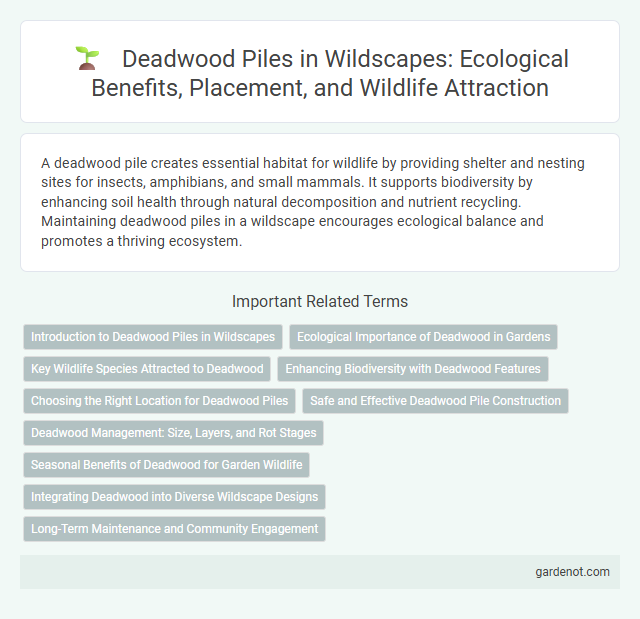A deadwood pile creates essential habitat for wildlife by providing shelter and nesting sites for insects, amphibians, and small mammals. It supports biodiversity by enhancing soil health through natural decomposition and nutrient recycling. Maintaining deadwood piles in a wildscape encourages ecological balance and promotes a thriving ecosystem.
Introduction to Deadwood Piles in Wildscapes
Deadwood piles in wildscapes serve as essential habitats, offering shelter and breeding grounds for a diverse range of wildlife including insects, amphibians, and small mammals. These decomposing wood structures enhance soil fertility by facilitating nutrient cycling and supporting fungal growth. Integrating deadwood piles into wildscape design promotes biodiversity and strengthens ecosystem resilience.
Ecological Importance of Deadwood in Gardens
Deadwood piles in gardens serve as critical habitats for a diverse range of wildlife, including insects, fungi, and small mammals, promoting biodiversity. These decomposing wood structures contribute to nutrient cycling by breaking down organic matter and enriching the soil with essential minerals. Incorporating deadwood into garden ecosystems supports natural pest control and enhances overall garden health through increased ecological balance.
Key Wildlife Species Attracted to Deadwood
Deadwood piles serve as critical habitats for key wildlife species such as woodpeckers, beetles, and amphibians, providing essential food sources and shelter. Species like the pileated woodpecker rely on decaying wood for nesting and foraging, while various beetle larvae contribute to nutrient cycling within these microhabitats. Amphibians benefit from the moist, shaded environment deadwood creates, supporting biodiversity in wildscapes.
Enhancing Biodiversity with Deadwood Features
Deadwood piles serve as essential microhabitats within wildscapes, supporting a diverse array of fungi, insects, and small vertebrates that contribute to ecosystem complexity. Incorporating deadwood features enhances soil fertility by promoting nutrient cycling and creating shelter for pollinators and decomposers. These natural structures increase habitat heterogeneity, which boosts overall biodiversity and resilience in forested environments.
Choosing the Right Location for Deadwood Piles
Selecting the right location for deadwood piles involves considering proximity to wildlife habitats and ensuring adequate shelter and food sources nearby. Deadwood piles should be placed in shaded, moist areas to promote decomposition and support biodiversity, attracting insects, amphibians, and small mammals. Positioning piles away from high-traffic zones minimizes disturbance, enhancing their effectiveness as refuges within a wildscape.
Safe and Effective Deadwood Pile Construction
Safe and effective deadwood pile construction in Wildscape involves selecting hardwood branches free of contaminants to provide habitat for insects, amphibians, and small mammals. Proper stacking ensures stability without compacting materials, allowing air circulation and moisture retention critical for biodiversity. Incorporating varied sizes and avoiding tight ties promotes decomposer activity and enhances the ecological function of the pile.
Deadwood Management: Size, Layers, and Rot Stages
Deadwood piles serve as critical habitats in wildscapes, with effective deadwood management focusing on size, layers, and rot stages to maximize biodiversity. Larger deadwood piles with multiple layers provide shelter and food resources for diverse species, while various rot stages support fungi, insects, and nutrient cycling. Properly managed deadwood ensures ecological balance by fostering wildlife habitats and enhancing soil health through decomposition processes.
Seasonal Benefits of Deadwood for Garden Wildlife
Deadwood piles provide essential seasonal benefits for garden wildlife by offering shelter and breeding sites during cold winters and hot summers, helping maintain biodiversity year-round. They support decomposers like fungi and insects that enrich soil nutrients, promoting healthy plant growth in every season. Many bird and small mammal species rely on deadwood habitats for nesting and foraging, making these piles crucial for sustaining local ecosystems throughout the year.
Integrating Deadwood into Diverse Wildscape Designs
Deadwood piles serve as essential microhabitats that enhance biodiversity by providing shelter and breeding grounds for insects, amphibians, and small mammals. Integrating deadwood into diverse wildscape designs supports natural decomposition processes and nutrient cycling, improving soil health and plant growth. Strategically placing varied sizes and types of deadwood mimics natural forest conditions, attracting pollinators and predators that contribute to a balanced ecosystem.
Long-Term Maintenance and Community Engagement
Effective long-term maintenance of a deadwood pile involves regular monitoring to ensure structural stability and habitat quality for diverse wildlife species such as beetles, fungi, and small mammals. Engaging the community through educational workshops and citizen science programs promotes awareness and stewardship, fostering a collaborative approach to conservation. Incorporating feedback from local residents helps adapt maintenance practices to regional ecological conditions, enhancing the deadwood pile's sustainability over time.
Deadwood pile Infographic

 gardenot.com
gardenot.com